Partial Discharge Wideband Full-Band High-Gain Resonant Cavity UHF Sensor Research
Abstract
:1. Introduction
2. Principle of Antenna
2.1. The Basic Principle of Monopole Patch Antenna
2.2. The Basic Principle of Microstrip Feeder Transmission Line
2.3. The Basic Principle of Fabry–Perot Resonant Cavity Antenna
3. Resonant Cavity UHF Antenna Sensor Design
3.1. Microstrip Monopole Patch Antenna Body Design
3.1.1. Antenna Design Based on Curved Flow Technology
3.1.2. Structural Optimization Based on Slot Dual Resonance
3.2. Partially Reflective Cladding Design and Combination
4. Antenna Performance Simulation Analysis
4.1. Voltage Standing Wave Ratio
4.2. Gain Direction Diagram
5. PD Detection Performance Test
5.1. PD Inspection Test Platform
5.2. Antenna Performance Comparison
6. Conclusions
- Optimization of monopole patch antenna by using the idea of curved-flow technology and slot dual resonance structure, which greatly broadens the operating band of the antenna sensor and improves the antenna gain directionality. Based on the idea of Fabry–Perot resonant cavity antenna, partial reflection cladding was set up, so that the antenna sensor can obtain full-band high gain performance. The simulated and measured results show that the designed resonant cavity monopole antenna has VSWR ≤ 5 in the frequency band of 0.37 GHz–3 GHz, excellent VSWR performance, average gain of 4.92 dBi, peak gain of 7.16 dBi at the main resonant frequency, simple fabrication process, and meets the design requirements of PD UHF antenna sensors.
- Through the constructed partial discharge test platform, the designed resonant cavity monopole antenna is used to detect the typical air gap discharge defects, and compared with the mature flexible monopole UHF antenna, the results show that the resonant cavity monopole antenna can detect the PD signal more obviously, which proves the feasibility of resonant cavity monopole antenna for PD detection and reflecting the PD radiation electromagnetic wave energy spectrum characteristics.
Author Contributions
Funding
Institutional Review Board Statement
Informed Consent Statement
Data Availability Statement
Conflicts of Interest
References
- Kap, S.C.; Wang, Y.Y.; Li, J.H.; Meng, Y.; Liang, N.F.; Sun, D.L.; Wang, W.H.; He, W.L. Research status and development of UHF antenna for GIS partial discharge detection. High Volt. Electron. 2015, 51, 163–172, 177. [Google Scholar]
- Wang, Y.X.; Yan, J.; Wang, J.H.; Geng, Y.G.; Liu, Z.Y. Intelligent diagnosis method for GIS insulation defects with small samples based on domain antagonistic migrating convolutional neural network. J. Electr. Eng. Technol. 2022, 37, 2150–2160. [Google Scholar]
- Zhang, X.S.; Zhang, J.; Xiao, S. Design of external UHF partial discharge sensor for large transformers. High Volt. Technol. 2019, 2, 6. [Google Scholar] [CrossRef]
- Zhang, C.S. Research on GIS partial discharge severity assessment method. Electr. Eng. Technol. 2023, 5, 3. [Google Scholar]
- Zhang, G.Z.; Chen, K.; Li, X.H.; Wang, K.; Fang, R.H.; Liu, J.B. Flexible built-in miniaturized Archimedean spiral antenna sensor for GIS PD detection. High Volt. Technol. 2022, 48, 11. [Google Scholar]
- Zhang, G.Z.; Han, J.Q.; Liu, J.B.; Chen, K.; Zhang, S. Research on GIS partial discharge detection antenna body and Barron coplanar flexible miniaturized UHF antenna sensor. J. Electr. Eng. Technol. 2023, 38, 12. [Google Scholar]
- Zhang, G.Z.; Zhang, S.; Zhang, X.X.; Chen, K.; Han, J.Q.; Liu, J.B. Research on new GIS partial discharge flexible built-in Archimedean spiral antenna. High Volt. Electr. 2022, 1–10. [Google Scholar]
- Zhang, S.; Zhang, G.; Lu, C.; Tian, H.; Liu, J.; Zhang, X. Flexible planar monopole built-in GIS PD sensor based on meandering technology. Sensors 2022, 22, 4134. [Google Scholar] [CrossRef]
- IEC 60270-2015; High-Voltage Test Techniques—Partial Discharge Measurements. International Electrotechnical Commission: Geneva, Switzerland, 2015.
- GB/T 7354-2018; High Voltage Test Techniques Partial Discharge Measurement. Standardization Administration Department of the State Council of China: Beijing, China, 2018.
- Liu, Y.; Isleifson, D.; Shafai, L. Wideband Dual-Polarized Octagonal Cavity-Backed Antenna with Low Cross-Polarization and High Aperture Efficiency. Sensors 2023, 23, 731. [Google Scholar] [CrossRef]
- Peng, L.H. Research and Design of High Gain Electrically Swept Antenna. Master’s Thesis, University of Electronic Science and Technology, Chengdu, China, 2022. [Google Scholar] [CrossRef]
- Nguyen, M.T.; Ferrero, F.; Trinh, L.-H. Compact UHF Circularly Polarized Multi-Band Quadrifilar Antenna for CubeSat. Sensors 2023, 23, 5361. [Google Scholar] [CrossRef]
- Ghouz, H.H.M.; Sree, M.F.A.; Ibrahim, M.A. Novel Wideband Microstrip Monopole Antenna Designs for WiFi/LTE/WiMax Devices. IEEE Access 2020, 8, 9532–9539. [Google Scholar] [CrossRef]
- Zhang, A.; Xu, W.T.; Xing, D.; Zhang, Z.Q.; Xin, D.L.; Gao, G.Q. Design of ultra-wideband monopole partial discharge detection antenna based on curvilinear flow technique. Electr. Appl. 2022, 41, 6. [Google Scholar]
- Qin, K.Y. Design of Broadband High-Gain Circularly Polarized Antenna. Master’s Thesis, Huaqiao University, Quanzhou, China, 2018. [Google Scholar]
- Calixto, S.; Zitzumbo, R.; Hernandez, Z.M. Fabry–Perot Interferometer Used to Measure Very Low Static Pressure Measurements. Sensors 2023, 23, 6493. [Google Scholar] [CrossRef] [PubMed]
- Lv, B.; Zhang, W.; Huang, W.; Li, F.; Li, Y. Narrow Linewidth Half-Open-Cavity Random Laser Assisted by a Three-Grating Ring Resonator for Strain Detection. Sensors 2022, 22, 7882. [Google Scholar] [CrossRef]
- Li, L. Research and Design of Low-Profile LTCC Microstrip Antenna Based on Fabry-Perot Resonant Cavity. Master’s Thesis, Chang an University, Xian, China, 2022. [Google Scholar] [CrossRef]
- Hua, Y.R. Research on Fabry-Perot High Gain Antenna and Polarization Tunable Technology. Master’s Thesis, Guilin University of Electronic Science and Technology, Guilin, China, 2021. [Google Scholar] [CrossRef]
- Li, Z.K. Research on Microstrip Antenna Array Technology Based on Fabry-Perot Resonant Cavity. Master’s Thesis, University of Electronic Science and Technology, Chengdu, China, 2020. [Google Scholar] [CrossRef]
- Hao, H.; Wang, S.; Gao, H.; Ma, X.; Huang, X. Low-Cost Broadband Circularly Polarized Array Antenna with Artificial Magnetic Conductor for Indoor Applications. Appl. Sci. 2023, 13, 3104. [Google Scholar] [CrossRef]
- Tian, Y.; Liu, Y.S.; Xiong, J.; Li, P.F.; Zhong, S.Q.; Zhou, W.J. Microstrip antenna for partial discharge detection based on curvilinear flow technique and genetic algorithm. Electr. Meas. Instrum. 2018, 55, 110–115, 121. [Google Scholar]
- Zhang, Q. Research on Miniaturized Broadband Patch Antenna Based on Curved Flow Technology. Master’s Thesis, Tianjin University, Tianjin, China, 2017. [Google Scholar]
- Gu, X.Y.; Chen, X. Research on enhancing antenna gain based on random dot matrix. Radio Eng. 2016, 46, 52–55. [Google Scholar]
- Nabil, M.; Faisal, M.M.A. Design, Simulation and Analysis of a High Gain Small Size Array Antenna for 5G Wireless Communication. Wirel. Pers. Commun. 2021, 116, 2761–2776. [Google Scholar] [CrossRef]
- Jahid, A.; Alsharif, M.H.; Hall, T.J. A contemporary survey on free space optical communication: Potentials, technical challenges, recent advances and research direction. J. Netw. Comput. Appl. 2022, 200, 103311. [Google Scholar] [CrossRef]
- Shi, W.C. Optimized Design of Broadband High-Gain Super-Surface Antenna. Master’s Thesis, University of Chinese Academy of Sciences, Beijing, China, 2021. [Google Scholar] [CrossRef]
- Zhang, K.F. Design of Broadband Circularly Polarized Antenna. Master’s Thesis, Chongqing University of Posts and Telecommunications, Chongqing, China, 2021. [Google Scholar] [CrossRef]
- Zhao, J.B.; Shi, J.K.; He, Y.J. Miniaturized omnidirectional high-gain antenna based on impedance surface loading. Radio Eng. 2022, 52, 186–191. [Google Scholar]
- Li, T.; Yang, H.; Li, Q.; Jidi, L.; Cao, X.; Gao, J. Broadband Low-RCS and High-Gain Microstrip Antenna Based on Concentric Ring-Type Metasurface. IEEE Trans. Antennas Propag. 2021, 69, 5325–5334. [Google Scholar] [CrossRef]
- Okabe, S.; Kaneko, S.; Yoshimura, M.; Muto, H.; Nishida, C.; Kamei, M. Propagation characteristics of electromagnetic waves in three-phase-type tank from viewpoint of partial discharge diagnosis on gas insulated switchgear. IEEE Trans. Dielectr. Electr. Insul. 2009, 16, 199–205. [Google Scholar] [CrossRef]
- Wang, P.; Ma, S.; Akram, S.; Meng, P.; Castellon, J.; Li, Z.; Montanari, G.C. Design of an effective antenna for partial discharge detection in insulation systems of inverter-fed motors. IEEE Trans. Ind. Electron. 2021, 69, 13727–13735. [Google Scholar] [CrossRef]
- Hu, X.; Zhang, G.; Liu, X.; Chen, K.; Zhang, X. Design of High-Sensitivity Flexible Low-Profile Spiral Antenna Sensor for GIS Built-in PD Detection. Sensors 2023, 23, 4722. [Google Scholar] [CrossRef]
- Kasabegoudar, V.G.; Reddy, P. A Review of Low Profile Single Layer Microstrip Antennas. Int. J. Electr. Electron. Eng. Telecommun. 2022, 11, 122–131. [Google Scholar] [CrossRef]
- Zhou, E.; Cheng, Y.; Chen, F. Wideband and high-gain patch antenna with reflective focusing metasurface. AEU-Int. J. Electron. Commun. 2021, 134, 153709. [Google Scholar] [CrossRef]
- D’Agostino, F.; Ferrara, F.; Gennarelli, C.; Guerriero, R.; Migliozzi, M. TD optimal sampling interpolation over a plane from NF data collected through a non-conventional plane-rectangular scanning. IET Microw. Antennas Propag. 2017, 11, 1681–1686. [Google Scholar] [CrossRef]
- D’Agostino, F.; Ferrara, F.; Gennarelli, C.; Guerriero, R.; Migliozzi, M. Optimal sampling interpolation over a plane from transient bi-polar near-field data. IET Microw. Antennas Propag. 2016, 10, 1445–1452. [Google Scholar] [CrossRef]
- Q/GdW 11304.8-2019; Technical Specification for Live Detection Instruments for Power Equipment, Part 8: UHF Method Partial Discharge Live Detector Technical Specification. STATE GRID Corporation of China: Beijing, China, 2019.
- Zhang, H.; Zhang, G.; Zhang, X.; Tian, H.; Lu, C.; Liu, J.; Zhang, Y. PD flexible built-in high-sensitivity elliptical monopole antenna sensor. Sensors 2022, 22, 4982. [Google Scholar] [CrossRef]
- Rui, Y.F.; Wang, Y.L.; Zhou, M.Y.; Luo, Y.; Wang, H.T.; Sun, H.; Yin, Y. Joint sensing technology of GIS partial discharge based on flexible feeder spiral antenna and silicon photomultiplier tube. Chin. J. Electr. Eng. 2023, 43, 3610–3621. [Google Scholar] [CrossRef]
- Rui, Y.F.; Wang, Y.L.; Zhou, M.Y.; Luo, Y.; Wang, H.T.; Yin, Y. Design and application of high gain flexible fed stereo spiral antenna for partial discharge detection. High Volt. Technol. 2022, 48, 1865–1876. [Google Scholar] [CrossRef]
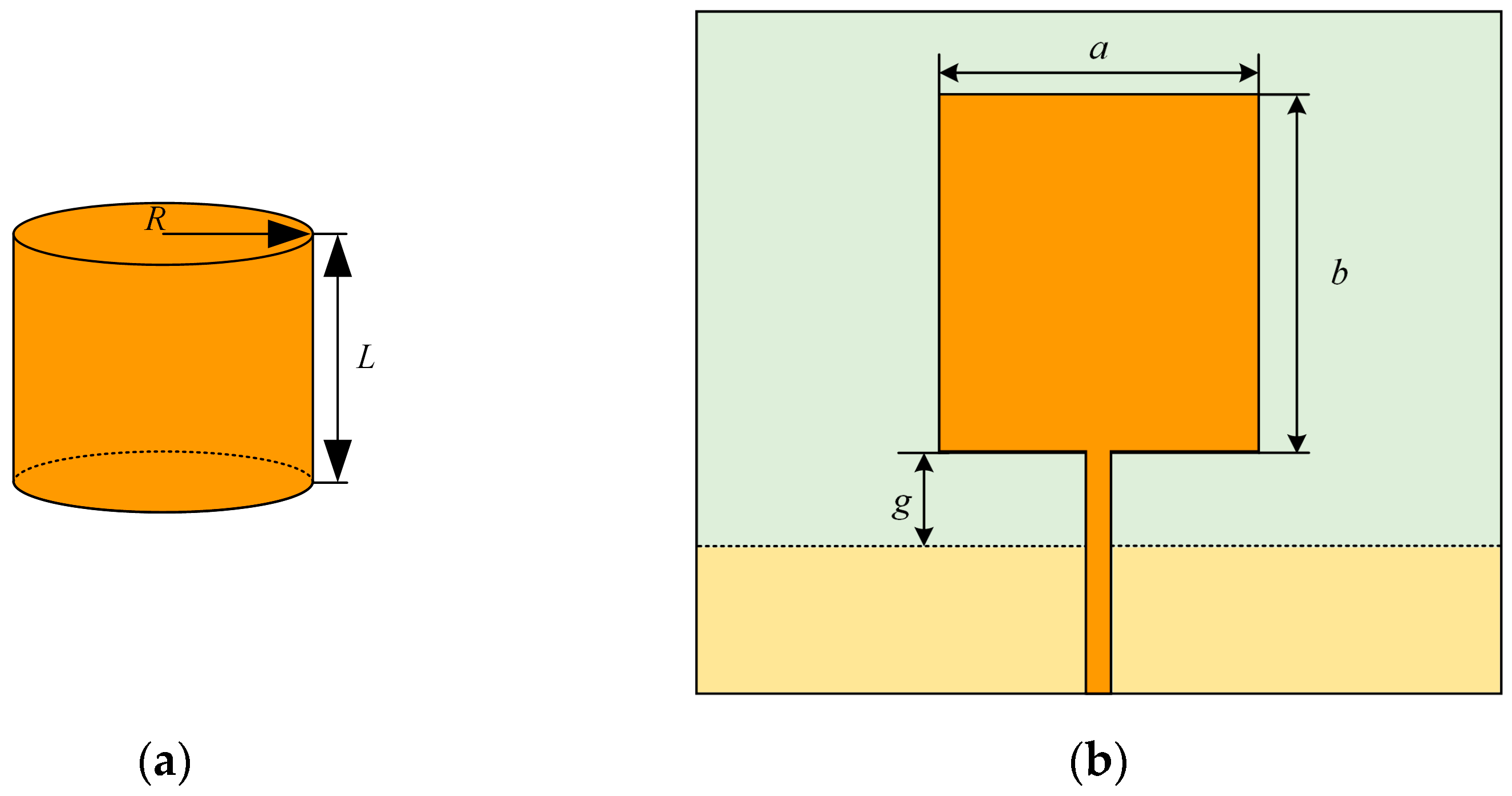
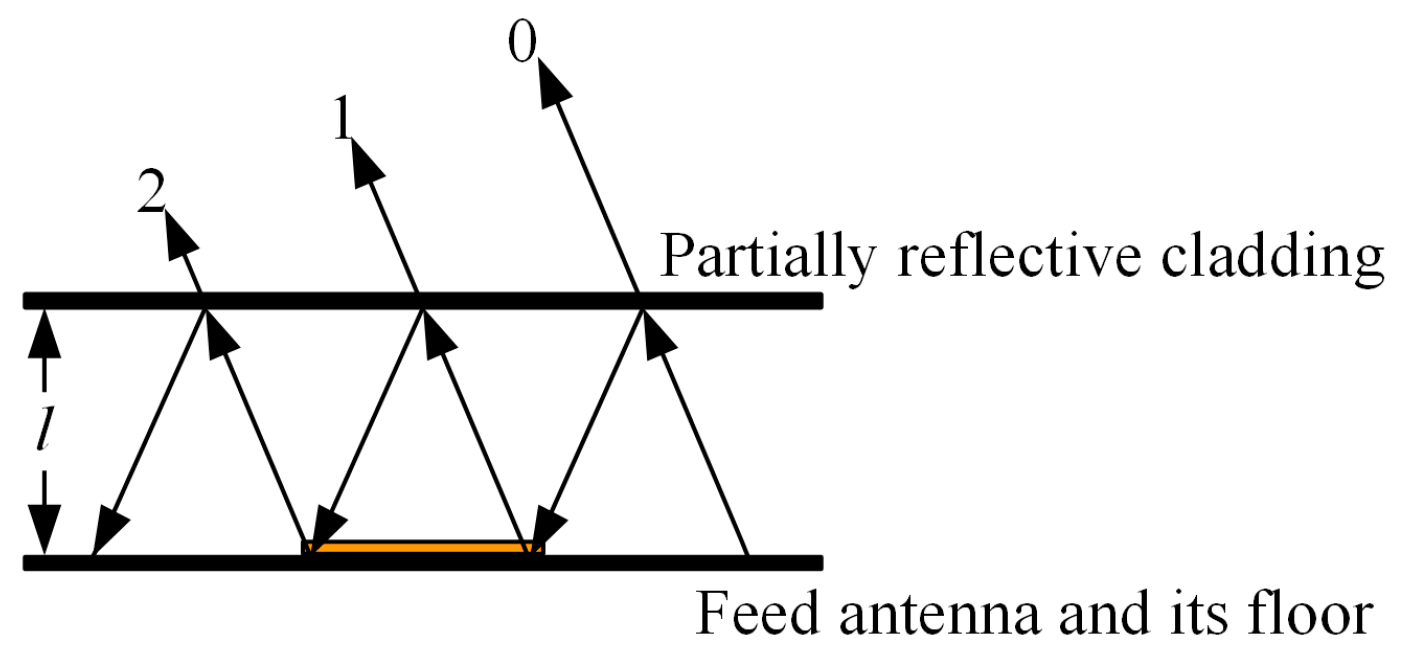
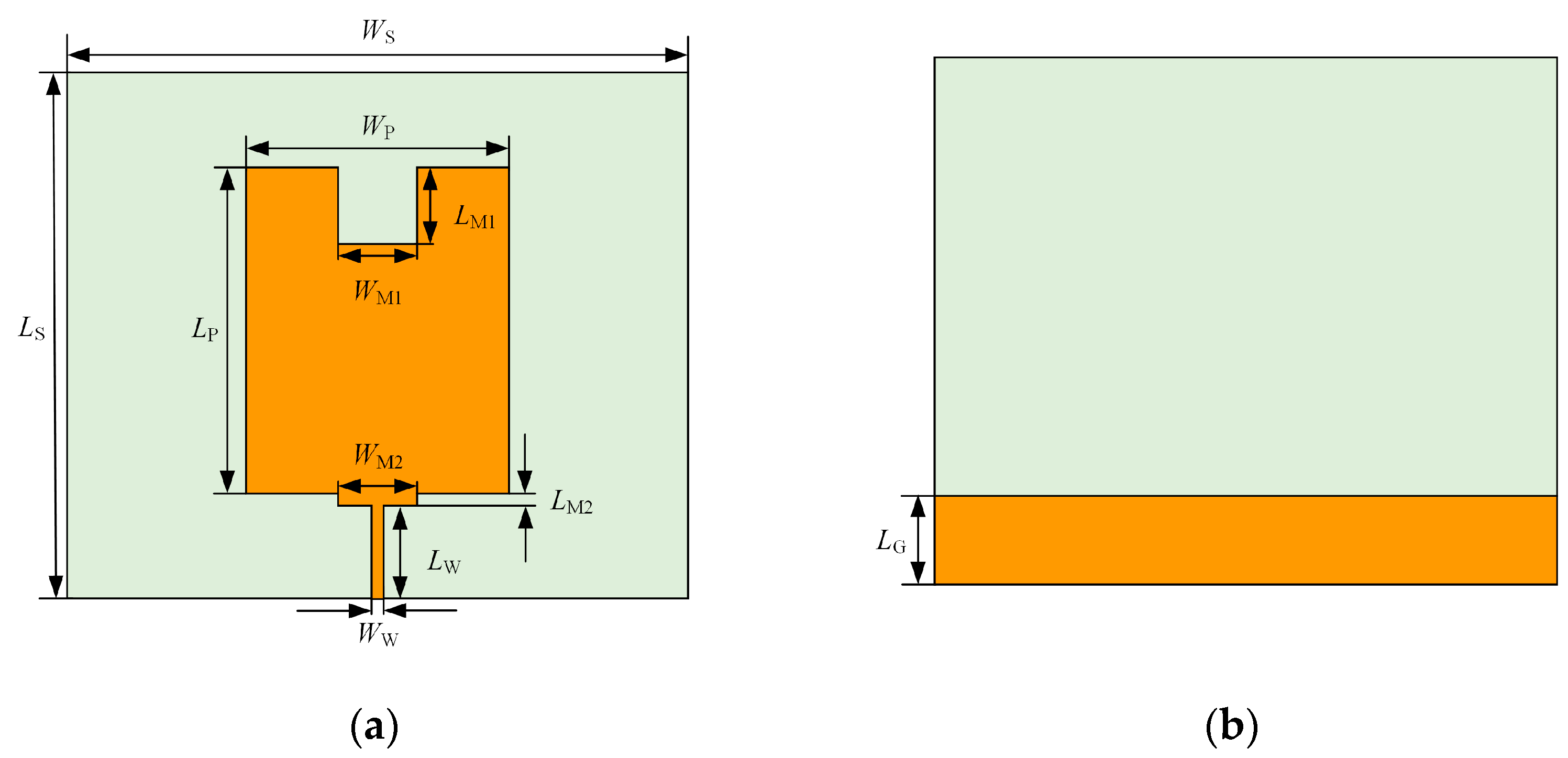
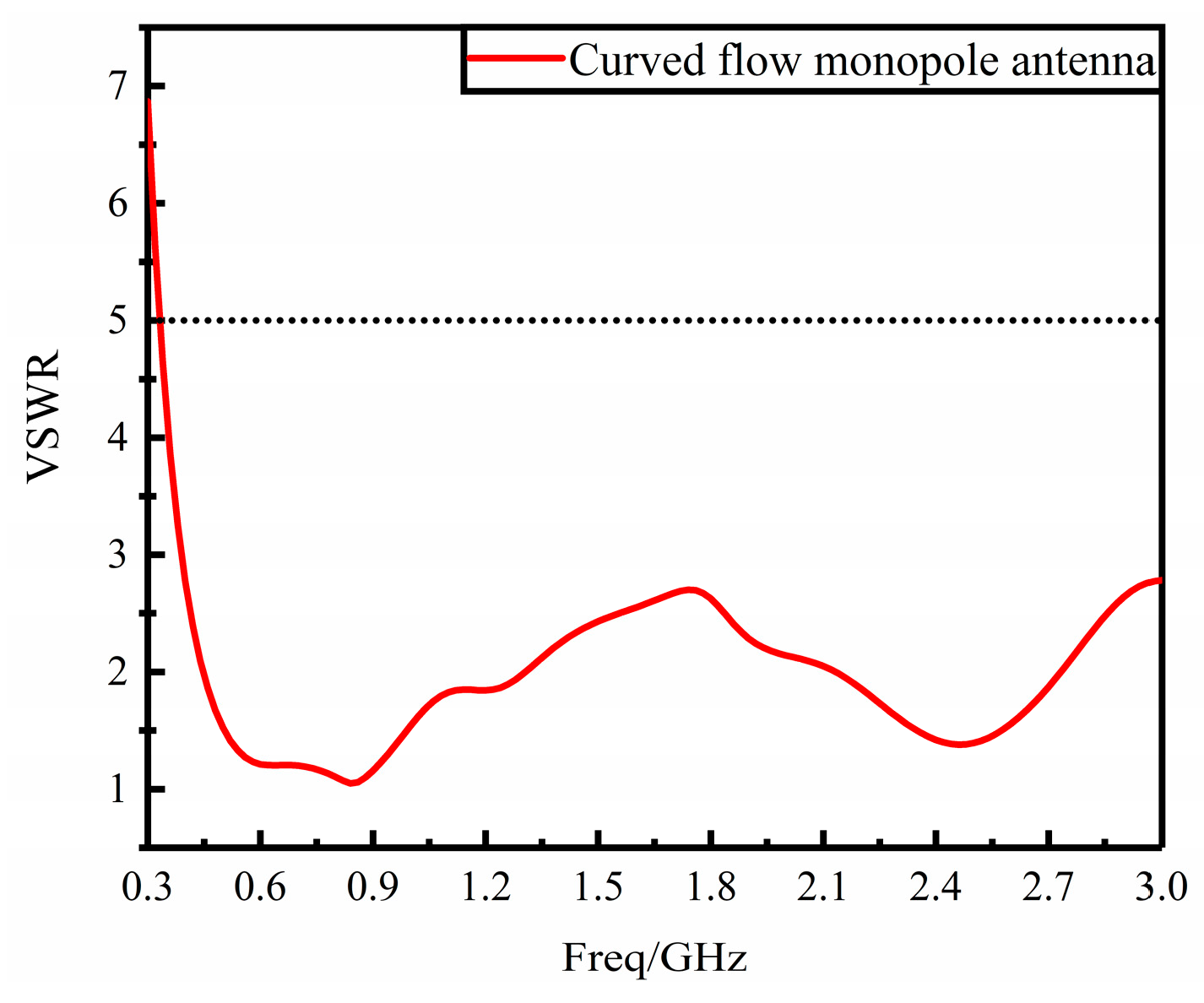
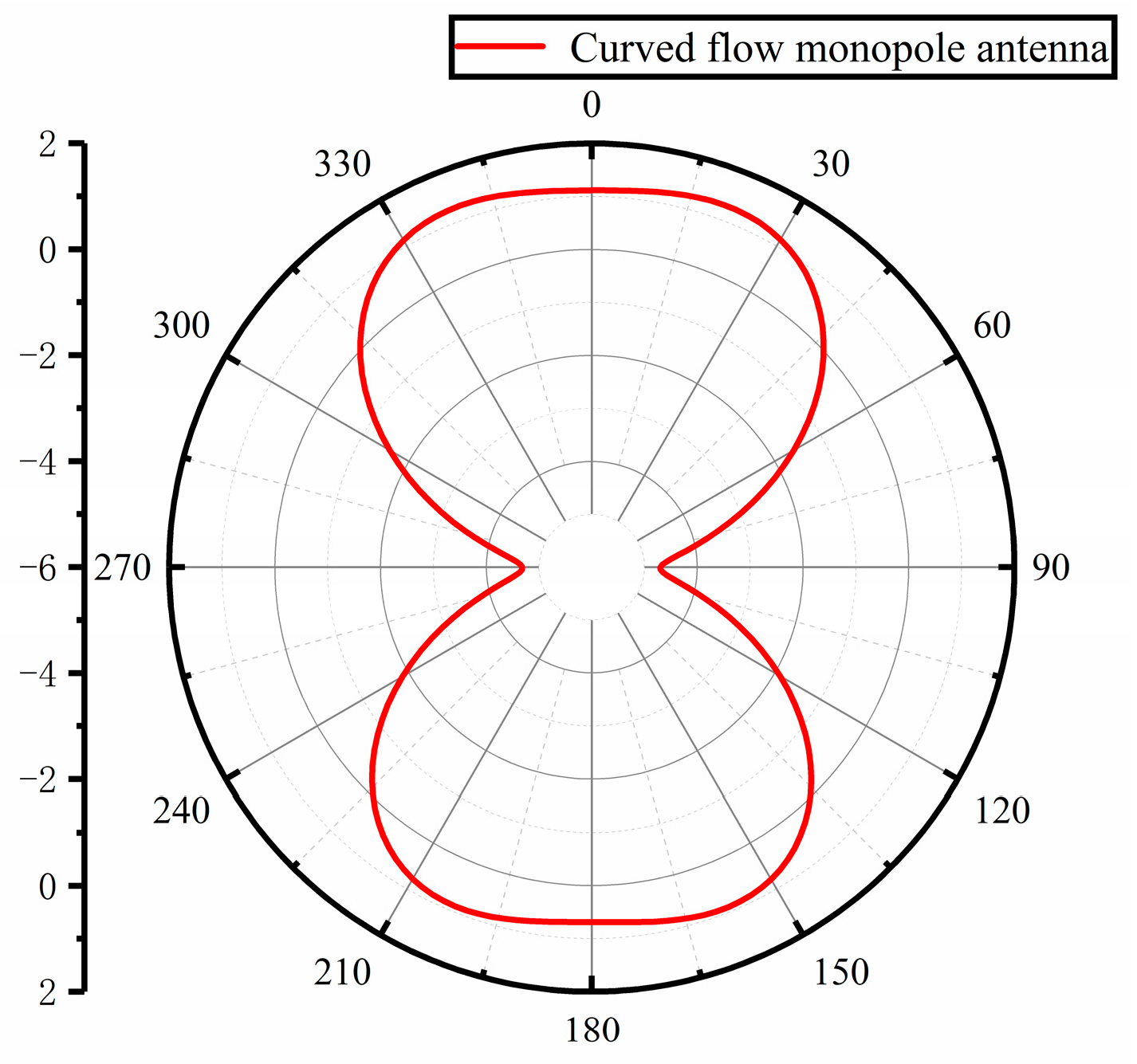


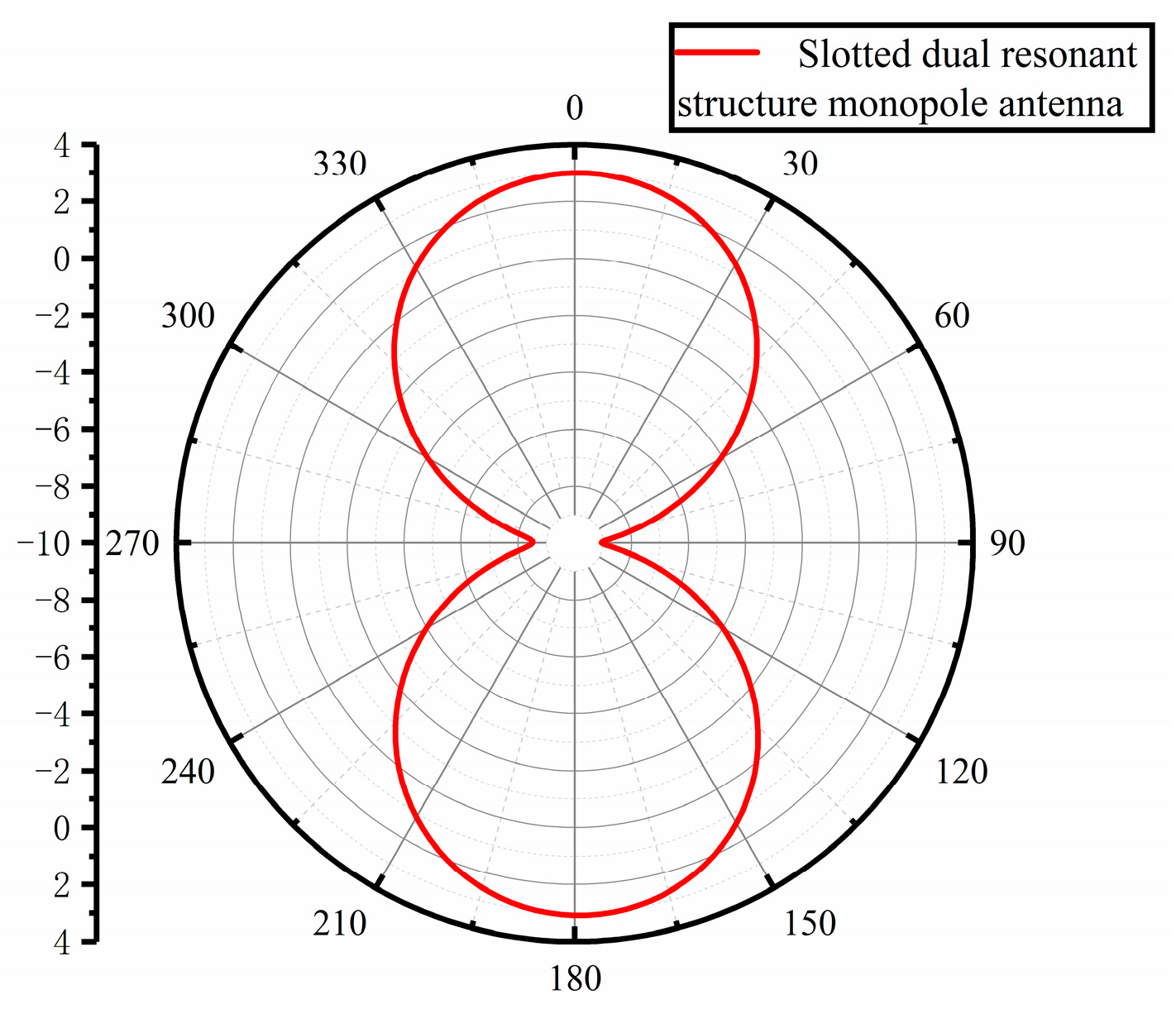




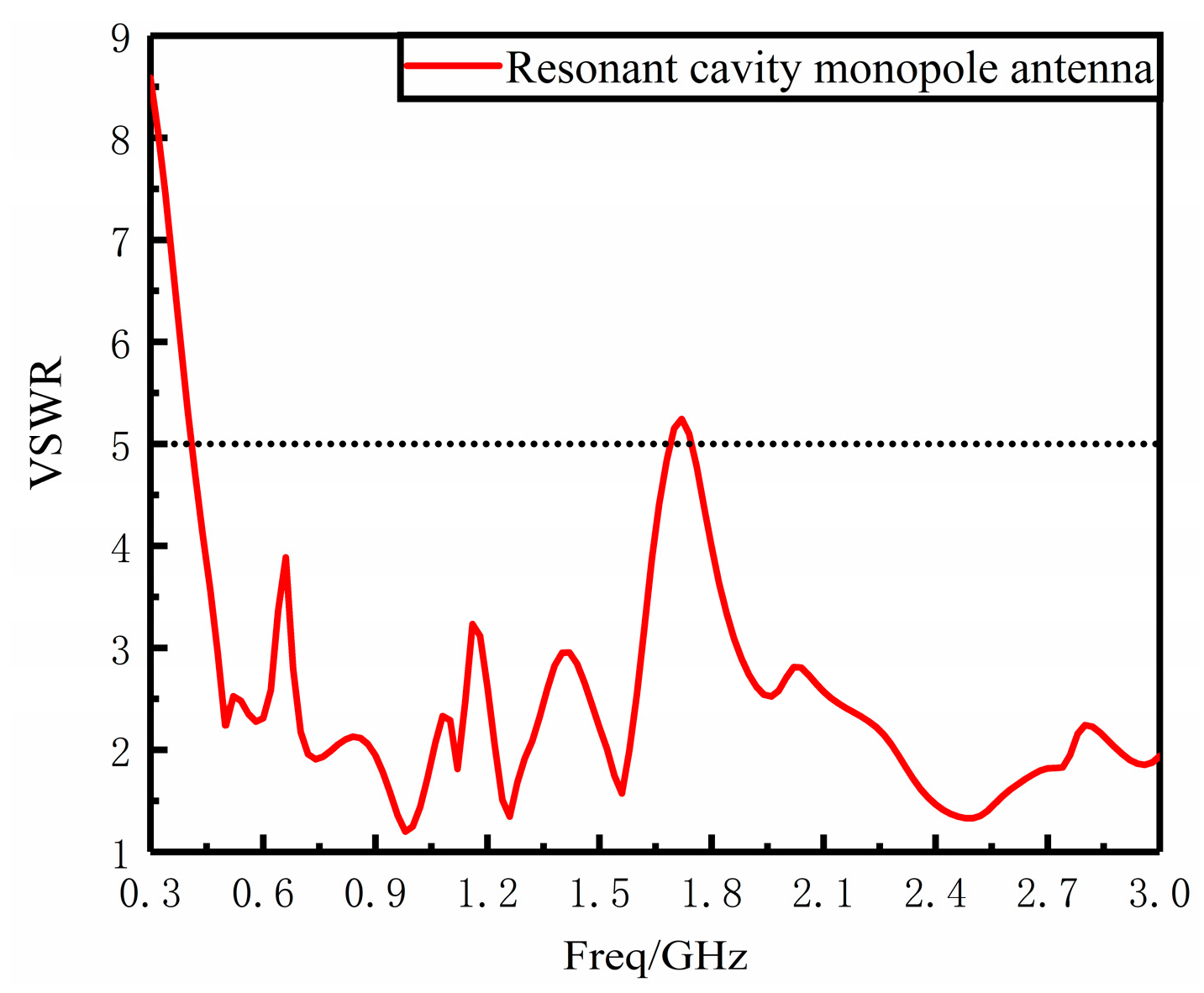

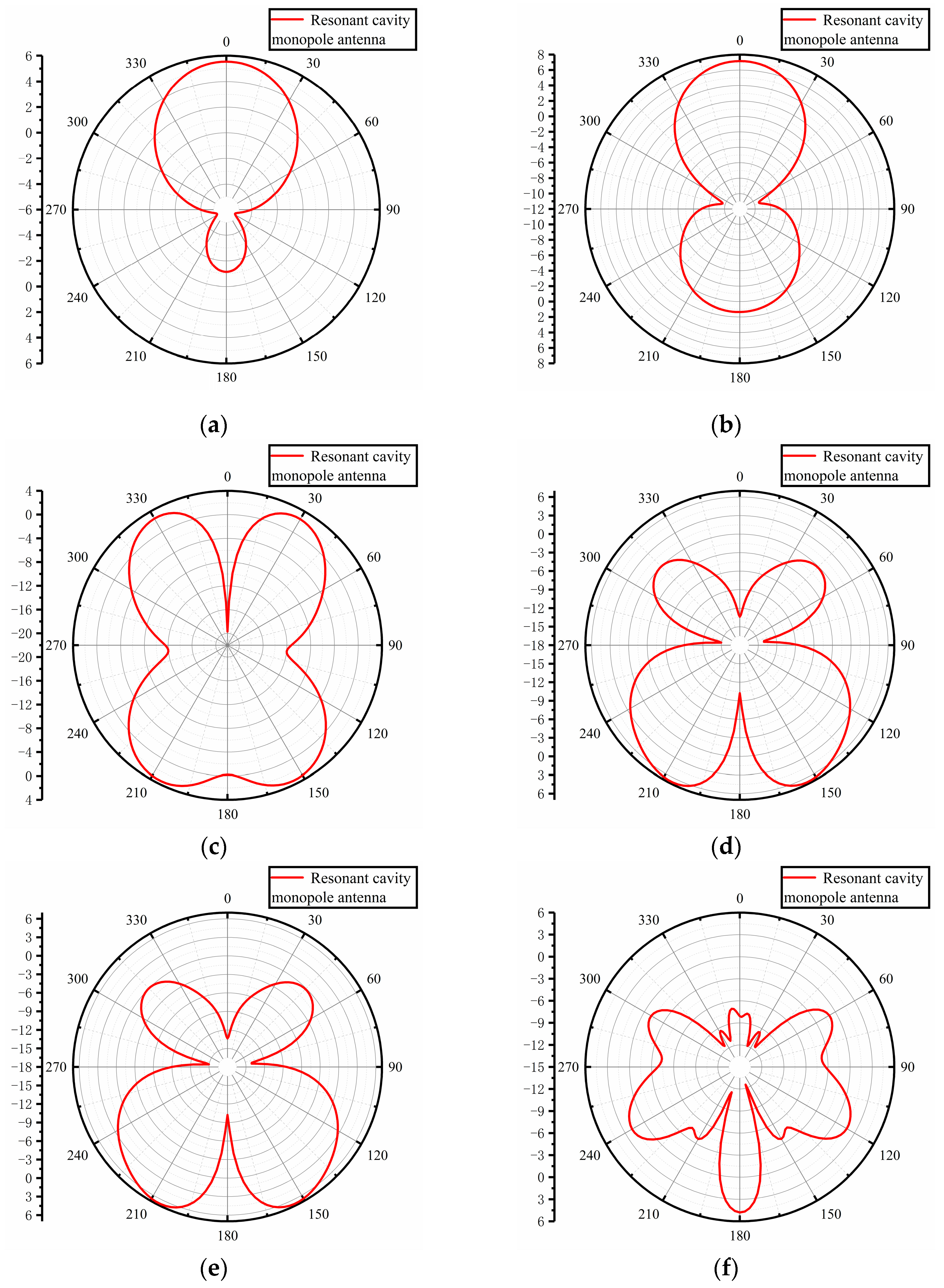
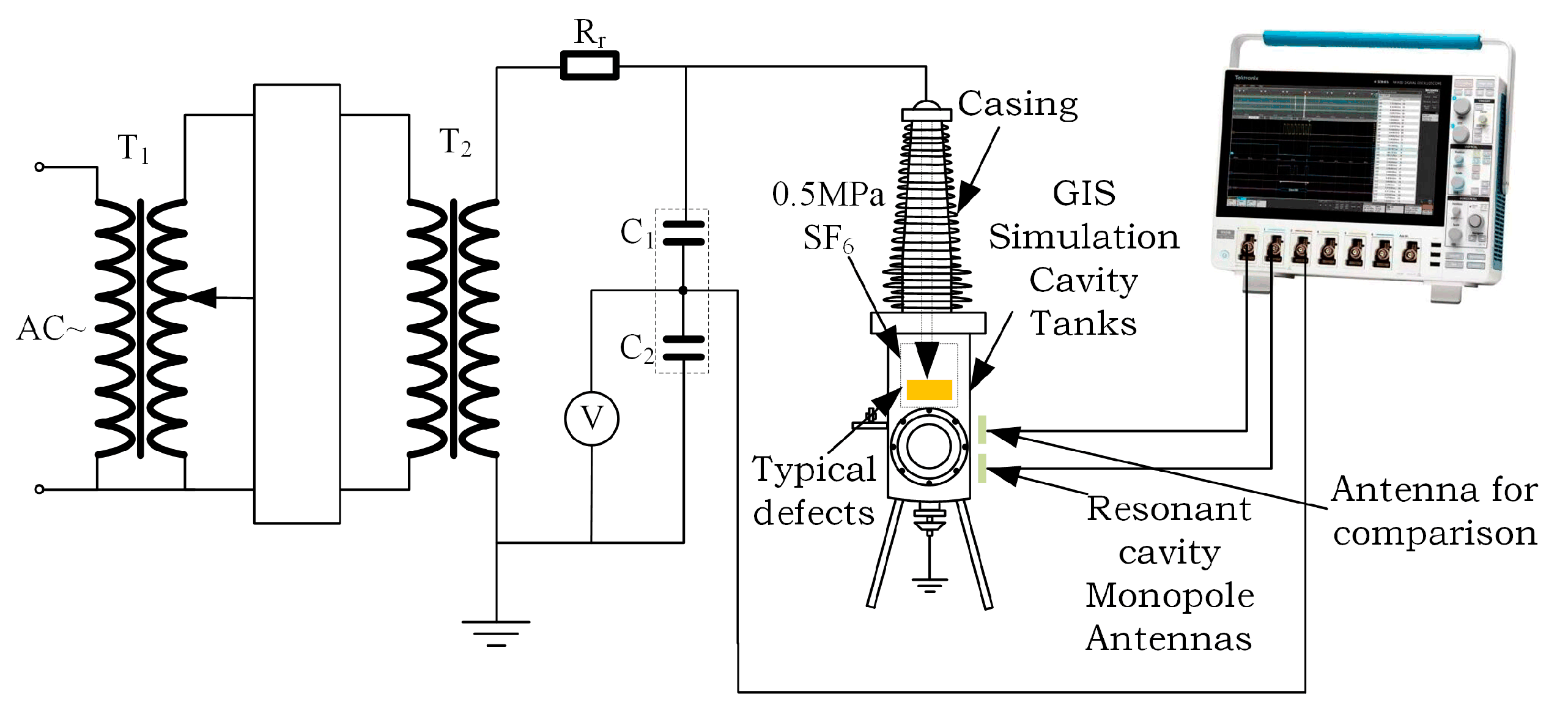
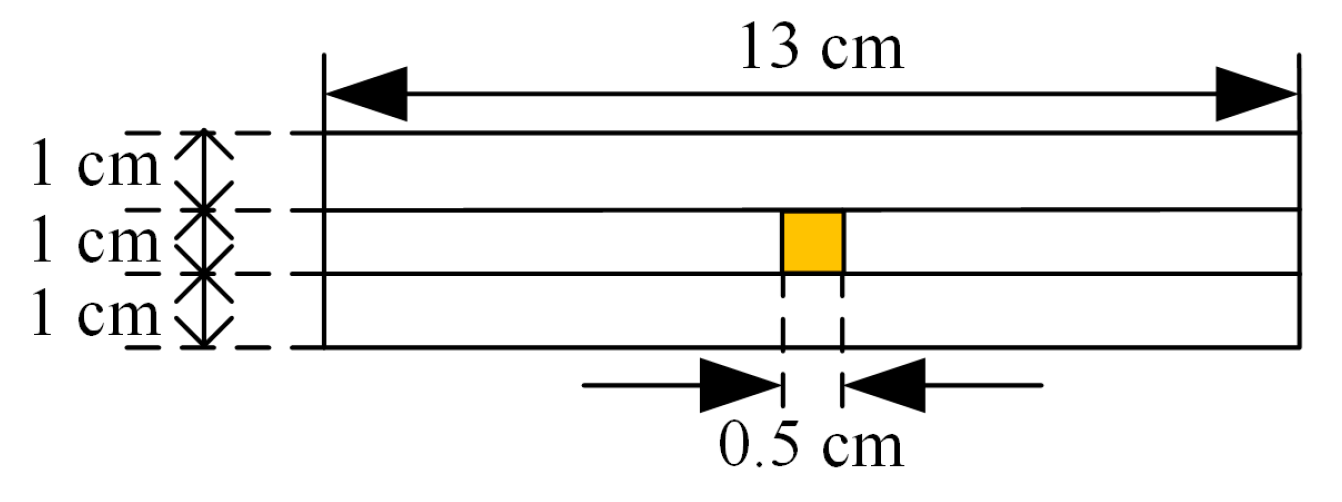
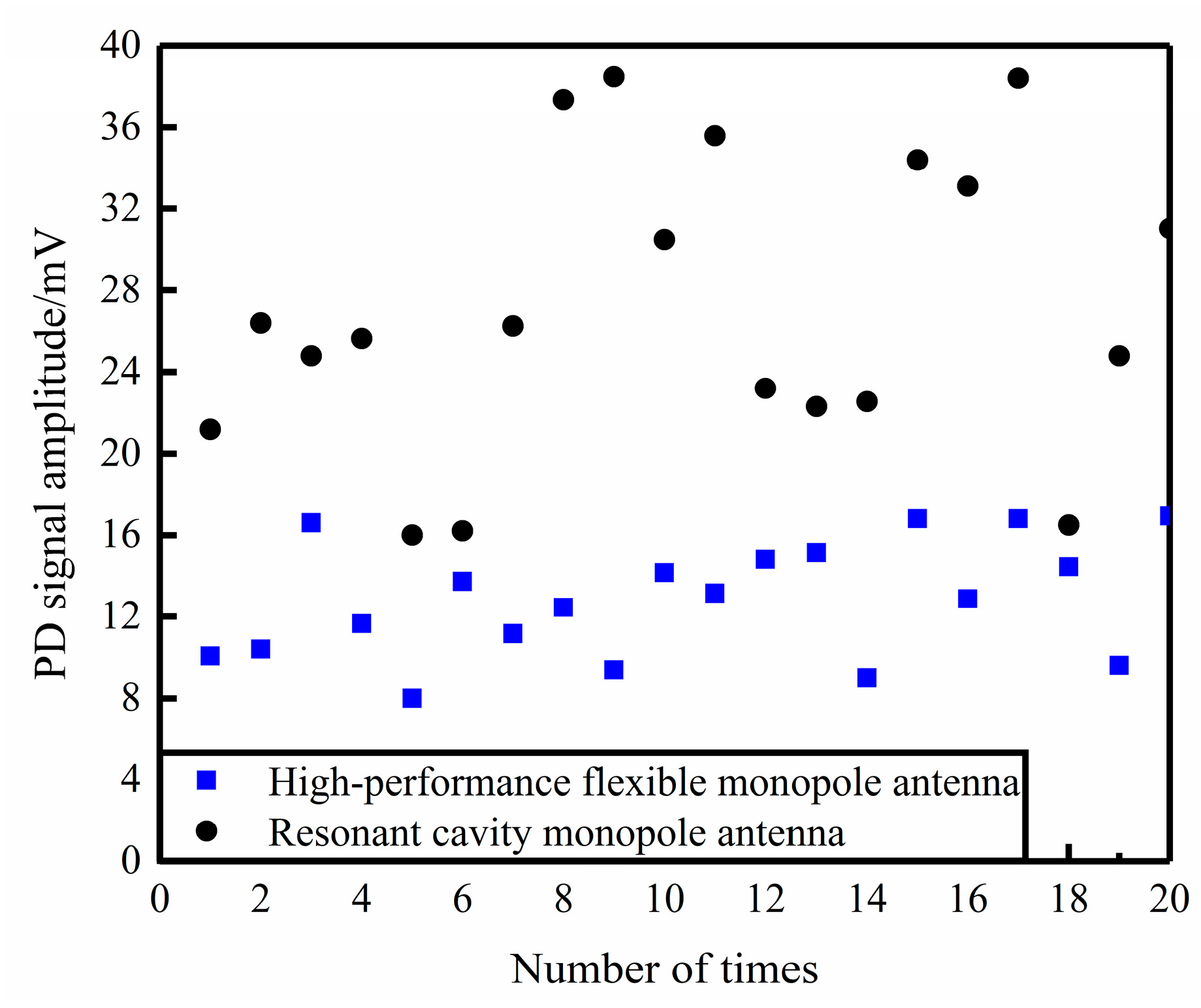

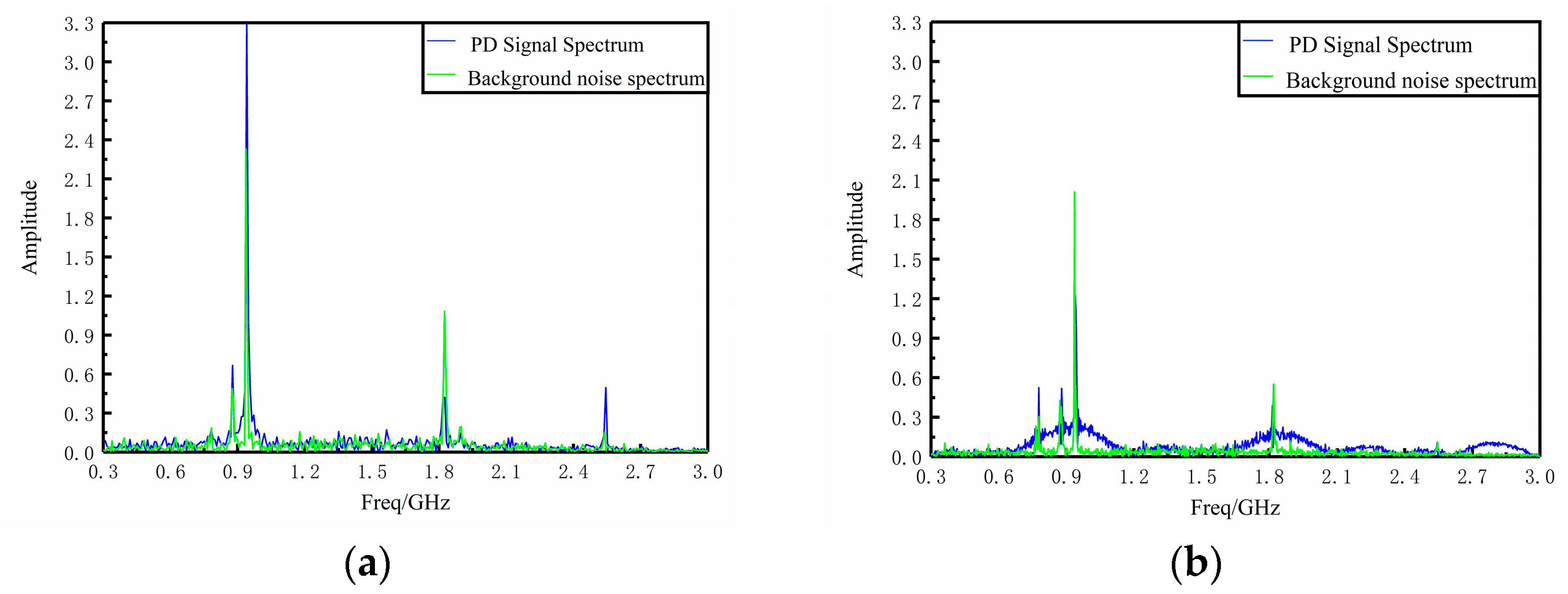
| Parameters | Value (mm) |
|---|---|
| Substrate length LS | 205.2 |
| Substrate width WS | 241.2 |
| Patch length LP | 134.0 |
| Patch width WP | 120.6 |
| Rectangular slot length LM1 | 42.9 |
| Rectangular slot width WM1 | 60.9 |
| Step structure length LM2 | 6.7 |
| Step structure width WM2 | 44.2 |
| Microstrip line length LW | 53.6 |
| Microstrip line width WW | 5.1 |
| Dielectric substrate thickness h | 2.8 |
| Floor length LG | 48.9 |
| Parameters | Value (mm) |
|---|---|
| Upper border length LA | 5.0 |
| Isosceles triangle side length WT | 25.0 |
| Left and right border width WA | 5.0 |
| Large rectangle arm width WA3 | 40.6 |
| Small rectangle arm width WA2 | 20.0 |
| Lower border length LB | 11.0 |
| Frequency Points | Maximum Gain |
|---|---|
| 0.7 GHz | 5.54 dBi |
| 1.0 GHz | 7.16 dBi |
| 1.4 GHz | 3.46 dBi |
| 2.0 GHz | 6.70 dBi |
| 2.4 GHz | 6.71 dBi |
| 3.0 GHz | 4.79 dBi |
Disclaimer/Publisher’s Note: The statements, opinions and data contained in all publications are solely those of the individual author(s) and contributor(s) and not of MDPI and/or the editor(s). MDPI and/or the editor(s) disclaim responsibility for any injury to people or property resulting from any ideas, methods, instructions or products referred to in the content. |
© 2023 by the authors. Licensee MDPI, Basel, Switzerland. This article is an open access article distributed under the terms and conditions of the Creative Commons Attribution (CC BY) license (https://creativecommons.org/licenses/by/4.0/).
Share and Cite
Liao, C.; Zhang, L.; Zhang, G.; Lu, C.; Zhang, X. Partial Discharge Wideband Full-Band High-Gain Resonant Cavity UHF Sensor Research. Sensors 2023, 23, 6847. https://doi.org/10.3390/s23156847
Liao C, Zhang L, Zhang G, Lu C, Zhang X. Partial Discharge Wideband Full-Band High-Gain Resonant Cavity UHF Sensor Research. Sensors. 2023; 23(15):6847. https://doi.org/10.3390/s23156847
Chicago/Turabian StyleLiao, Chengqiang, Lei Zhang, Guozhi Zhang, Changyue Lu, and Xiaoxing Zhang. 2023. "Partial Discharge Wideband Full-Band High-Gain Resonant Cavity UHF Sensor Research" Sensors 23, no. 15: 6847. https://doi.org/10.3390/s23156847






